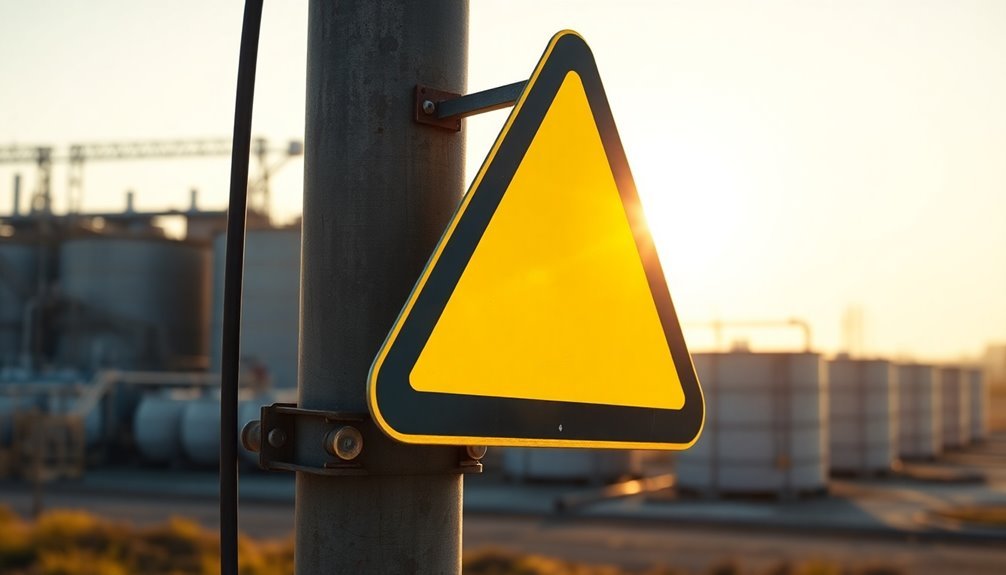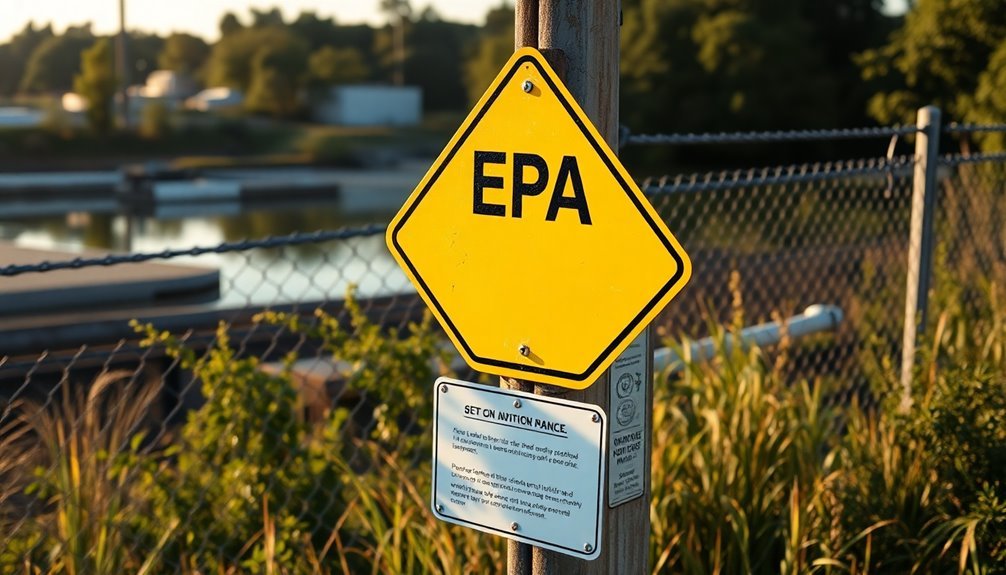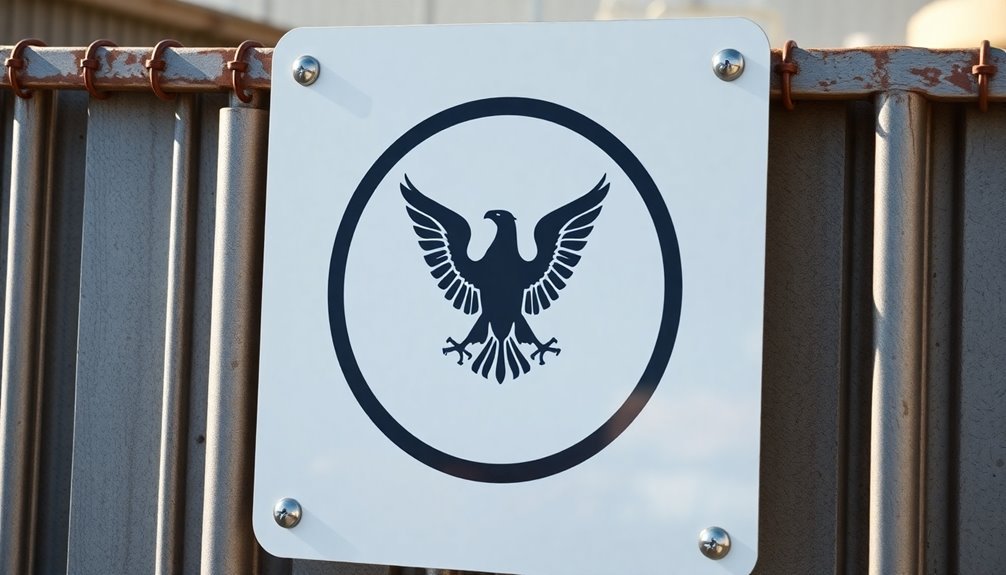You'll need to follow strict EPA guidelines when setting up warning signs for your project. Make signs 72 inches wide by 48 inches high, displaying the EPA emblem in standard colors (blue PMS 660 and green PMS 362) or a single contrasting color. Place signs at all access points, worker entry areas, and walking routes within 21 days of project start. Guarantee your signs remain visible day and night, using reflective materials when needed. Follow ANSI Z535 color standards: red for danger, orange for warnings, and yellow for caution. There's much more to take into account for full compliance with federal regulations.
EPA Sign Design Standards

EPA sign design standards consistently follow strict color-coding and format requirements to guarantee maximum safety and clarity. You'll need to use black legends and borders on red backgrounds for danger signs, while caution signs require yellow backgrounds.
Signs must follow the ANSI Z535 standard to ensure proper safety compliance. For safety instruction signs, use white backgrounds with black letters and green top panels, and choose blue backgrounds for general notice signs unrelated to hazards.
When designing your signs, you'll want to follow standard shapes, with warning signs typically being diamond-shaped. You must guarantee sufficient size to allow ample viewing time before hazard encounters, and all rigid signs should feature rounded corners to prevent injury.
You'll need to incorporate standardized symbols for specific hazards, mandatory actions, and prohibited activities to guarantee universal recognition.
Maintain uniform layouts and clear word formatting throughout your safety signage. You'll need to keep your symbols consistent across all signs to prevent confusion.
Remember to review and update your signage periodically to reflect the latest safety guidelines, and guarantee your collateral materials match the information presented on your safety signs.
Warning Sign Placement Guidelines
When you're installing EPA warning signs, you'll need to follow strict visibility and distance requirements, including mounting heights of 4-6 feet and maximum spacing of 100 feet between signs.
You must consider site-specific factors like wetland boundaries, lot lines, and available mounting options such as trees or posts.
Your sign placement should account for both day and night visibility while ensuring adequate perception time for viewers to identify and react to the warnings.
Visibility and Distance Rules
Three core principles govern EPA warning sign placement: visibility, legibility, and strategic positioning. You'll need to make certain your warning signs are visible from all typical worker entry points and easily readable by an ordinary individual under normal conditions.
When placing warning signs, you must use diamond-shaped signs with black text on yellow backgrounds, unless specific regulations indicate otherwise. Your warning symbols shouldn't be smaller than the height of the word "WARNING," and you'll need to position signs at every access road, border with labor camps, and established walking routes.
For high-judgment conditions, you'll want to place signs at a legibility distance of 50 meters (175 feet).
In greenhouses, post signs at all doorways, aisles, and walking routes that lead to treated areas. If there aren't obvious entry points, you'll need to install signs in the corners of the treated area.
You should regularly evaluate sign effectiveness during both day and night conditions.
When placing multiple warning signs with different messages, maintain adequate spacing to allow for driver comprehension and reaction time, particularly in urban areas where distractions are common.
Site Location Factors
Throughout agricultural and treated areas, effective warning sign placement depends on carefully evaluating site-specific factors that influence visibility and worker safety.
You'll need to identify and mark all potential entry points, including access roads, established walking paths, and borders adjacent to labor camps. For areas without clear entry points, you must post signs at the corners of treated zones.
When placing warning signs, you'll want to focus on strategic locations that maximize visibility while guaranteeing workers can easily spot them before entering restricted areas. Signs should be placed 6 to 12 feet from travel paths and work areas. In greenhouse settings, concentrate on posting signs at doorways and along frequently used aisles.
You should mount all signs securely to prevent them from falling or being displaced by wind or other environmental factors.
Consider your workforce's language needs and post signs in all necessary languages to facilitate thorough understanding. You must follow the Worker Protection Standard's requirements for sign format and content while maintaining proper timing: post signs within 24 hours before application, keep them up during the REI period, and remove them within three days after the REI expires.
Document your sign placement decisions to demonstrate compliance and maintain consistent safety protocols.
Essential Compliance Requirements

According to EPA regulations, proper warning signage serves as a critical component of environmental and safety compliance. You'll need to follow specific requirements when installing EPA project signs, which must measure 72 inches wide by 48 inches high and display the EPA emblem. The signs should be placed in easily visible locations that directly connect to the work site, and you can choose between blue or white backgrounds.
When dealing with asbestos warnings, you must post labels in routine maintenance areas with specific wording: "CAUTION: ASBESTOS. HAZARDOUS. DO NOT DISTURB WITHOUT PROPER TRAINING AND EQUIPMENT." You'll need to check these labels every six months, though they're not required in public spaces like cafeterias or auditoriums.
For all warning signs, you must guarantee they meet ANSI and OSHA standards. Your signs should feature rounded corners, remain visible whenever hazards exist, and be removed when dangers are no longer present.
Don't forget to educate your employees about sign meanings and necessary precautions. If you're marking environmental protection areas, space your signs 100 feet apart and mount them 4-6 feet above ground on posts that extend at least 24 inches below the surface.
Sign Maintenance Best Practices
You'll need to establish a routine inspection schedule to check your EPA warning signs for damage, fading, and cleanliness throughout the construction period.
When you spot weather-related issues like loose fasteners or water damage, make immediate repairs to maintain compliance and prevent further deterioration.
Your signs must remain clearly visible to the intended audience at all times, so regularly clear any obstructions and verify proper lighting conditions around the signage.
Regular Inspections And Cleaning
Maintaining EPA warning signs requires a consistent schedule of inspections and proper cleaning protocols to guarantee their effectiveness. You'll need to conduct regular visual checks by standing approximately 30 feet away from each sign, using a flashlight to assess its reflectivity and legibility.
Keep inspection tools handy, including adhesive sheeting and aluminum tape for quick field repairs.
When cleaning sign faces, use soft cloths and mild detergents to remove dirt and grime without damaging the surface. You'll need to clear any vegetation that might obstruct visibility, particularly in critical areas.
Don't forget to check the sign's visibility at night, as compromised reflectivity can create dangerous conditions for viewers.
Document all inspections and maintenance work in your records to track the sign's condition over time. You must also verify that sign supports remain stable and securely anchored, regularly checking for rust or deterioration.
When performing maintenance, follow EPA-specific requirements and FHWA guidelines to maintain compliance. Remember to take into account environmental factors like wind and weather, and implement anti-vandalism measures using special fasteners to prevent theft or tampering.
Repairing Weather-Related Damage
Weather-related damage to EPA warning signs calls for a systematic approach in both assessment and repair. You'll need to evaluate the severity of damage, identifying signs that pose immediate safety hazards and prioritizing repairs based on their critical importance.
Document your assessment process thoroughly for future reference and planning.
When conducting repairs, you'll want to address bent signs by straightening them if possible, but replace them if the damage compromises their integrity. For damaged sign faces, repair or replace them to maintain proper retroreflectivity and legibility. Don't forget to check and repair sign supports to guarantee they remain stable and crashworthy. Given that methane emissions control is critical for addressing climate change, maintaining clear and legible warning signs is essential.
If you can't make immediate repairs, implement temporary solutions like warning devices.
Use appropriate tools and materials for repairs, including specific adhesives and retroreflective materials designed for sign maintenance. You'll need to guarantee all replacement parts meet safety standards.
To prevent future weather-related damage, establish regular maintenance schedules and secure signs before severe weather events. It's vital to use high-quality materials and consider weather factors in sign placement.
Train your maintenance team on proper repair techniques to maintain consistency in your sign maintenance program.
Sign Visibility Checks
Proper sign visibility forms the backbone of an effective EPA warning system. You'll need to conduct regular inspections of your EPA warning signs to guarantee they remain visible and legible to their intended audience.
Check that vegetation, debris, or other objects aren't blocking the signs, and verify that support structures remain secure and properly anchored.
When evaluating visibility, guarantee there's a clear line of sight from the viewer's perspective. You'll want to remove or relocate any obstructions like trees, buildings, or competing signage that might interfere with the sign's visibility.
Consider the angle of view and make sure your signs aren't overshadowed by surrounding visual elements.
Pay close attention to environmental factors affecting visibility. Choose materials and coatings that maximize visibility in various weather conditions and lighting situations.
You'll need to use appropriate reflective materials for nighttime visibility and select weather-resistant components that can withstand wind, rain, and other environmental challenges.
Remember that aging signs may lose their effectiveness over time, so incorporate regular evaluations of material condition into your visibility checks.
Project Duration Signage Rules

Project duration signage involves several critical requirements that you must follow when implementing EPA-funded projects. You'll need to fabricate and erect signs within 21 days of receiving the notice to proceed, and you're responsible for maintaining them throughout the entire construction period.
The signs must display the EPA logo and clearly indicate EPA funding while meeting standardized size requirements of 72 inches by 48 inches.
During the project, you'll need to guarantee your signs remain in good condition and visible to the public. Regular inspections are necessary to verify that signs are undamaged, readable, and free from visual obstructions. Remember that you must place signs in locations directly connected to the work being performed.
Key requirements for project duration signage include:
- Signs must remain in good condition throughout the entire construction period
- You must maintain clear visibility and routinely check for damage or obstruction
- All signs must consistently display mandatory elements, including the EPA logo and funding information
Be sure to take into account both EPA guidelines and local regulations, as additional requirements may apply depending on your location, such as specific rules in Chicago.
Visibility and Location Factors
Beyond maintaining signs during construction, understanding visibility and location requirements for EPA warning signs is fundamental to workplace safety. You'll need to guarantee warning signs are visible and legible from all usual entry points, including access roads and walking routes. For greenhouses, make sure signs are visible from doorways and aisles.
When placing warning signs, you must post them at all entrances to treated areas on farms, forests, and nurseries. Don't forget to include signs at borders with labor camps and along established walking routes. If there aren't clear entry points, place signs in corners or other easily visible locations. Following OSHA requirements, all signs must have rounded corners to minimize injury risks.
| Location Type | Placement Requirement | Visibility Need |
|---|---|---|
| Farm Entry | All access roads | Clear from approach |
| Greenhouse | Doorways and aisles | Visible from walkways |
| Forest Area | Main entrances | Readable from distance |
| Labor Camps | Adjacent borders | Clear line of sight |
| Walking Routes | Established paths | Unobstructed view |
Remember to position signs away from movable objects and guarantee they're well-illuminated. You'll need to maintain them in a legible condition throughout their required posting period, and they should be visible from a safe distance to effectively warn workers of potential hazards.
EPA Logo Display Specifications

The official EPA logo must adhere to strict display requirements across all warning signs and materials. When you're displaying the EPA logo, you'll need to maintain its integrity by using either the standard color scheme (blue PMS 660 and green PMS 362) or a single uniform color that complements the background. The logo should not exceed 5% of the surface of any given page or display area.
Don't alter the logo's proportions or merge it with other illustrations, as this violates federal guidelines.
You must guarantee adequate clear space around the logo, approximately one-third of the graphic box height, and maintain a minimum size of 1.0" height on signs. If you're an external party, you'll need explicit permission from the Office of Public Affairs before using the logo, and you may need to include a disclaimer to prevent misinterpretation.
Key display specifications include:
- The logo must appear in either standard colors (blue and green) or a single contrasting color
- The flower and text within the logo can't be different colors or modified separately
- The logo requires adequate clear space and can't be smaller than 1.0" in height on signs
Remember that any deviation from these specifications requires OPA approval, and unauthorized use could result in legal consequences.
Frequently Asked Questions
Can EPA Warning Signs Be Temporarily Removed During Extreme Weather Conditions?
You shouldn't remove EPA warning signs during extreme weather. Instead, you'll need to secure them properly. If there's no specific guidance, it's best to maintain warnings while implementing additional protective measures.
Are Digital or LED Versions of EPA Warning Signs Acceptable Alternatives?
You'll find that digital or LED warning signs aren't explicitly approved in EPA guidelines. While they offer energy benefits, you should stick with traditional signs until specific regulations address digital alternatives.
What Happens if Vandals Damage or Steal the EPA Sign?
If vandals damage or steal your EPA signs, you'll face regulatory violations and potential fines. You must report the incident immediately and replace the signs to protect public safety and maintain legal compliance.
Can Multiple Smaller EPA Signs Replace One Large Required Sign?
You can't replace a large required sign with multiple smaller ones. It's against EPA regulations and could create confusion. You must maintain proper sign size to guarantee clear visibility and effective warnings.
Are EPA Warning Signs Required for Emergency Repairs Under EPA Funding?
You're not required to post EPA warning signs for emergency repairs, but you'll still need EPA funding signage. While some requirements are waived in emergencies, EPA-funded projects must maintain public awareness through proper signage.
In Summary
You'll need to regularly inspect and maintain your EPA warning signs while ensuring they meet all current compliance standards. Keep your signs visible, properly placed, and in good condition throughout your project's duration. When you're displaying the EPA logo, follow their strict specifications for size and placement. By staying diligent with these requirements, you'll maintain safety standards and avoid potential violations.





Leave a Reply